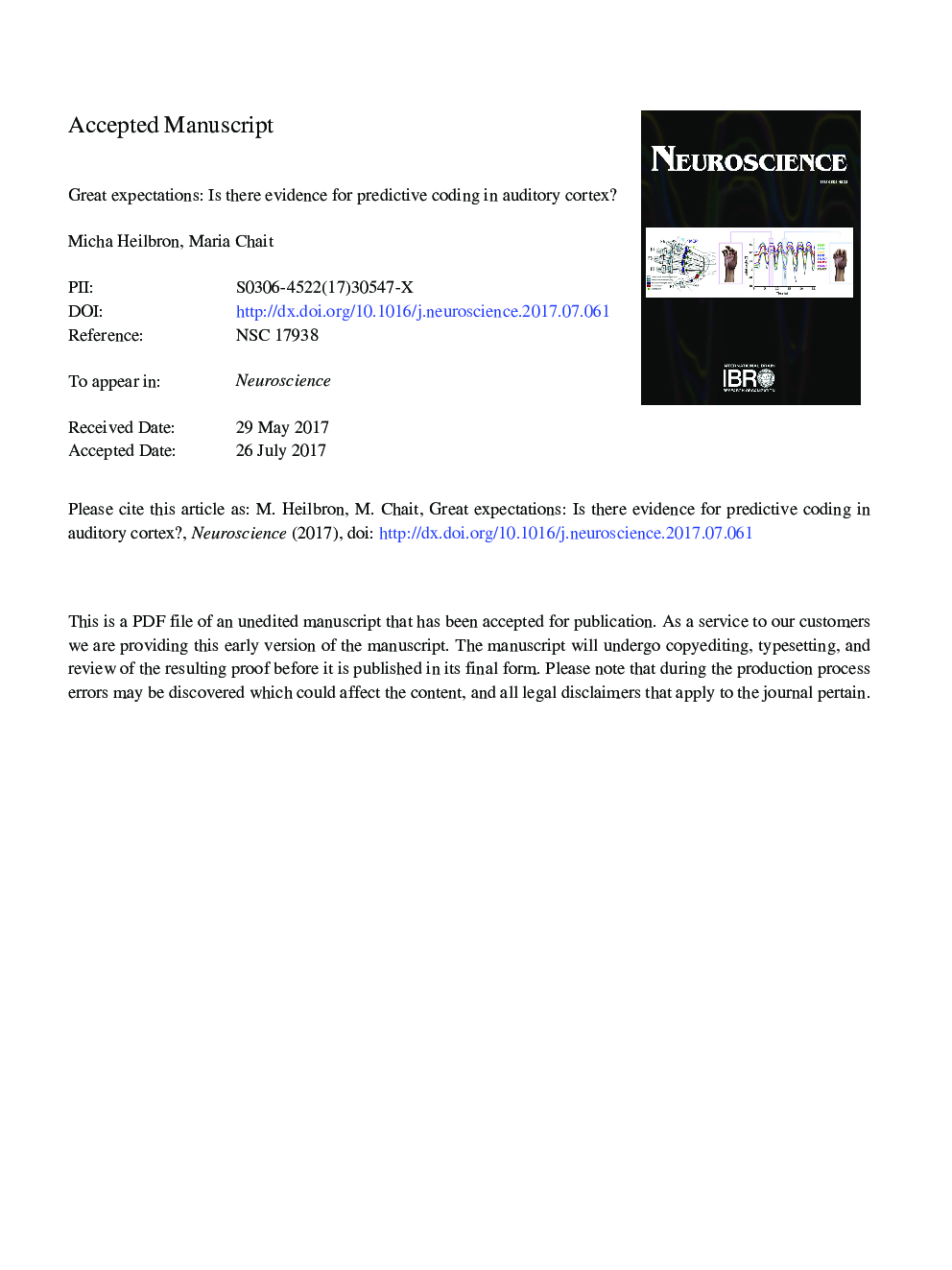| کد مقاله | کد نشریه | سال انتشار | مقاله انگلیسی | نسخه تمام متن |
|---|---|---|---|---|
| 11017835 | 1720566 | 2018 | 63 صفحه PDF | دانلود رایگان |
عنوان انگلیسی مقاله ISI
Great Expectations: Is there Evidence for Predictive Coding in Auditory Cortex?
ترجمه فارسی عنوان
انتظارات بزرگ: آیا شواهد برای کد گذاری پیش بینی در قشر گوش دادن وجود دارد؟
دانلود مقاله + سفارش ترجمه
دانلود مقاله ISI انگلیسی
رایگان برای ایرانیان
کلمات کلیدی
ترجمه چکیده
برنامه نویسی پیش بینی شده احتمالا یکی از تاثیرات، جامع ترین و بحث برانگیز ترین تئوری های عملکرد عصبی است. در حالی که طرفداران این پتانسیل توضیحی را ستایش می کنند، منتقدان معتقدند که اصول کلیدی این نظریه، تست نشده یا حتی غیرقابل انکار است. در مقاله حاضر، شواهد موجود برای برنامه نویسی پیش بینی شده در روش های شنوایی مورد بررسی قرار گرفته است. به طور خاص، ما پنج فرضیه اصلی از نظریه را شناسایی کرده و هر کدام را با توجه به مطالعات حیوانی، انسان و مدلسازی پردازش الگوی شنیداری ارزیابی می کنیم. برای دو فرضیه اول - پاسخ های عصبی به واسطه انتظارات شکل می گیرد و این انتظارات به طور سلسله مراتبی سازمان یافته اند - مطالعات حیوانی و انسانی شواهد قانع کننده ای ارائه می دهند. ماهیت پیش بینی پیش بینی های این انتظارات نیز از حمایت تجربی، به ویژه از مطالعات درمورد عدم اجبار غیرمنتظره برخوردار است. با این حال، برای وجود خطاهای جداگانه و نورونهای پیش بینی، فرض کلیدی تئوری، شواهد وجود ندارد. کارهای بیشتری بر روی امضاهای نوسان نوسان پیشنهادی کدگذاری پیش بینی شده و ارتباط بین توجه و دقت وجود دارد. با این حال، نتایج حاصل از این دو فرضیه دوم مخلوط یا متناقض است. به دنبال آینده، همکاری بیشتر بین مطالعات انسان و حیوانات، با کمک تجزیه و تحلیل مبتنی بر مدل، برای تست فرضیه های خاص و پیاده سازی برنامه نویسی پیش بینی شده مورد نیاز است و به همین ترتیب کمک می کند تا تعیین کند آیا این نظریه بزرگ مردمی می تواند انتظارات خود را برآورده کند.
موضوعات مرتبط
علوم زیستی و بیوفناوری
علم عصب شناسی
علوم اعصاب (عمومی)
چکیده انگلیسی
Predictive coding is possibly one of the most influential, comprehensive, and controversial theories of neural function. While proponents praise its explanatory potential, critics object that key tenets of the theory are untested or even untestable. The present article critically examines existing evidence for predictive coding in the auditory modality. Specifically, we identify five key assumptions of the theory and evaluate each in the light of animal, human and modeling studies of auditory pattern processing. For the first two assumptions - that neural responses are shaped by expectations and that these expectations are hierarchically organized - animal and human studies provide compelling evidence. The anticipatory, predictive nature of these expectations also enjoys empirical support, especially from studies on unexpected stimulus omission. However, for the existence of separate error and prediction neurons, a key assumption of the theory, evidence is lacking. More work exists on the proposed oscillatory signatures of predictive coding, and on the relation between attention and precision. However, results on these latter two assumptions are mixed or contradictory. Looking to the future, more collaboration between human and animal studies, aided by model-based analyses will be needed to test specific assumptions and implementations of predictive coding - and, as such, help determine whether this popular grand theory can fulfill its expectations.
ناشر
Database: Elsevier - ScienceDirect (ساینس دایرکت)
Journal: Neuroscience - Volume 389, 1 October 2018, Pages 54-73
Journal: Neuroscience - Volume 389, 1 October 2018, Pages 54-73
نویسندگان
Micha Heilbron, Maria Chait,
